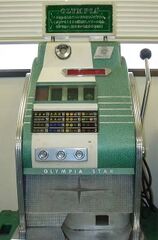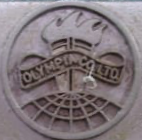Difference between revisions of "Olympia Star"
From Sega Retro
m (+flyer) |
m (→History) |
||
| (11 intermediate revisions by the same user not shown) | |||
| Line 1: | Line 1: | ||
{{Bob | {{Bob | ||
| image=OlympiaStar SlotMachine.jpg | | image=OlympiaStar SlotMachine.jpg | ||
| − | | publisher=Olympia | + | | publisher=[[Olympia (company)|Olympia]] |
| − | | developer=[[Sega]] | + | | developer=[[Sega Enterprises]] |
| + | | support={{company|[[Taito]]{{intref|Olympia (company)}}|role=concept and design}} | ||
| system=Slot machine | | system=Slot machine | ||
| releases={{releasesArcade | | releases={{releasesArcade | ||
| Line 8: | Line 9: | ||
}} | }} | ||
}} | }} | ||
| − | {{ | + | {{stub}}'''''{{PAGENAME}}''''' (オリンピア・スター) is a slot machine released in Japan around 1964 which reuses the shell of the [[Star series|''Star'' series]]. Produced by [[Olympia (company)|Olympia]], a joint venture between [[Sega Enterprises]] and [[Taito]]{{ref|1=https://blog.goo.ne.jp/nazox2016/e/d2691f40123ae387fedcc2b567659706}}, it introduced a form of legalized gambling to Japan which would establish the foundations of the future medal game industry.{{ref|1=https://blog.goo.ne.jp/nazox2016/e/d2691f40123ae387fedcc2b567659706}} |
| − | + | ==History== | |
| + | {{MainArticle|Olympia (company)}} | ||
| + | Around 1960, [[Taito]] conceptualized a way to circumvent Japan's anti-gambling laws by creating a slot machine which would use specialized tokens; these tokens would later be traded for real money.{{ref|1=https://blog.goo.ne.jp/nazox2016/e/71646fc259602a59deb9707332200cd4?fm=entry_awc}} By equipping their existing ''Royal Crown'' machine with this system, adding a stop button for the reels to add a weak element of skill, and categorizing the machine in the sex industry, Taito was surprisingly able to get government approval in 1964.{{ref|https://blog.goo.ne.jp/nazox2016/e/d2691f40123ae387fedcc2b567659706}} | ||
| − | + | [[File:Olympia logo.png|thumb|right|[[Olympia (company)|Olympia Co.]] emblem]] | |
| + | Taito's new version of the ''Royal Crown'' launched that year. However, it was soon noticed that [[Sega Enterprises]] was almost ready to launch their own identical machine.{{ref|1=https://blog.goo.ne.jp/nazox2016/e/71646fc259602a59deb9707332200cd4?fm=entry_awc}} An upset Taito then made its grievances known throughout the industry.{{ref|1=https://web.archive.org/web/20240129014038/https://blog.goo.ne.jp/nazox2016/e/f43ea93334695ed0ff036c2916b2a5be?fm=entry_awc}} | ||
| − | + | Ultimately, the two companies settled on a compromise (possibly related to both machines being copies of the same Mills product{{ref|1=https://web.archive.org/web/20240129014038/https://blog.goo.ne.jp/nazox2016/e/f43ea93334695ed0ff036c2916b2a5be?fm=entry_awc}}), and quickly formed a new joint venture, [[Olympia (company)|Olympia Co., Ltd.]], that same year.{{ref|1=https://blog.goo.ne.jp/nazox2016/e/f43ea93334695ed0ff036c2916b2a5be?fm=entry_awc}} The name was chosen by [[Taito]] to capitalize on Tokyo's [[wikipedia:1964 Summer Olympics|1964 Summer Olympics]] (without any license to do so). In this agreement, Sega would handle the manufacturing of the new slot machines, and Taito would manage their sales and marketing.{{ref|1=https://web.archive.org/web/20240129014038/https://blog.goo.ne.jp/nazox2016/e/f43ea93334695ed0ff036c2916b2a5be?fm=entry_awc}} This resulted in the ''[[Olympia Star]]'', released in 1964 almost immediately after the joint venture was established, and was the start of a [[Olympia series|long series]] of future ''Olympia'' machines. | |
| − | The '' | + | ===Legacy=== |
| + | The ''{{PAGENAME}}'' proved to be immensely popular, and soon coined a new term among the Japanese public, ''"Olympia Machines"''.{{ref|https://blog.goo.ne.jp/nazox2016/e/d2691f40123ae387fedcc2b567659706}} | ||
| + | |||
| + | ==Specifications== | ||
| + | ===Dimensions=== | ||
| + | {{Dimensions|hm=80|wm=42|dm=45|diagramsize=200|ref={{fileref|Olympiaseries SM JP flyer.jpeg}}}} | ||
==Promotional material== | ==Promotional material== | ||
| Line 25: | Line 34: | ||
==Photo gallery== | ==Photo gallery== | ||
<gallery> | <gallery> | ||
| − | Olympia Coin.jpg|Token( | + | OlympiaStar SM JP 2.png |
| + | OlympiaStar SM JP photo 2.png | ||
| + | OlympiaStar SM JP photo.png | ||
| + | Olympia Coin.jpg|Token (front) | ||
</gallery> | </gallery> | ||
Latest revision as of 22:03, 28 January 2024

| |||||||||
| Olympia Star | |||||||||
|---|---|---|---|---|---|---|---|---|---|
| System(s): Slot machine | |||||||||
| Publisher: Olympia | |||||||||
| Developer: Sega Enterprises | |||||||||
| Supporting companies: Taito[1] (concept and design) | |||||||||
|
This short article is in need of work. You can help Sega Retro by adding to it.
Olympia Star (オリンピア・スター) is a slot machine released in Japan around 1964 which reuses the shell of the Star series. Produced by Olympia, a joint venture between Sega Enterprises and Taito[3], it introduced a form of legalized gambling to Japan which would establish the foundations of the future medal game industry.[3]
Contents
History
- Main article: Olympia (company).
Around 1960, Taito conceptualized a way to circumvent Japan's anti-gambling laws by creating a slot machine which would use specialized tokens; these tokens would later be traded for real money.[4] By equipping their existing Royal Crown machine with this system, adding a stop button for the reels to add a weak element of skill, and categorizing the machine in the sex industry, Taito was surprisingly able to get government approval in 1964.[3]

Taito's new version of the Royal Crown launched that year. However, it was soon noticed that Sega Enterprises was almost ready to launch their own identical machine.[4] An upset Taito then made its grievances known throughout the industry.[5]
Ultimately, the two companies settled on a compromise (possibly related to both machines being copies of the same Mills product[5]), and quickly formed a new joint venture, Olympia Co., Ltd., that same year.[6] The name was chosen by Taito to capitalize on Tokyo's 1964 Summer Olympics (without any license to do so). In this agreement, Sega would handle the manufacturing of the new slot machines, and Taito would manage their sales and marketing.[5] This resulted in the Olympia Star, released in 1964 almost immediately after the joint venture was established, and was the start of a long series of future Olympia machines.
Legacy
The Olympia Star proved to be immensely popular, and soon coined a new term among the Japanese public, "Olympia Machines".[3]
Specifications
Dimensions
Promotional material
Photo gallery
References
- ↑ Olympia (company)
- ↑ http://thetastates.com/eremeka/1969prior.html (Wayback Machine: 2023-08-21 09:33)
- ↑ 3.0 3.1 3.2 3.3 https://blog.goo.ne.jp/nazox2016/e/d2691f40123ae387fedcc2b567659706
- ↑ 4.0 4.1 https://blog.goo.ne.jp/nazox2016/e/71646fc259602a59deb9707332200cd4?fm=entry_awc
- ↑ 5.0 5.1 5.2 https://blog.goo.ne.jp/nazox2016/e/f43ea93334695ed0ff036c2916b2a5be?fm=entry_awc (Wayback Machine: 2024-01-29 01:40)
- ↑ https://blog.goo.ne.jp/nazox2016/e/f43ea93334695ed0ff036c2916b2a5be?fm=entry_awc
- ↑ File:Olympiaseries SM JP flyer.jpeg




